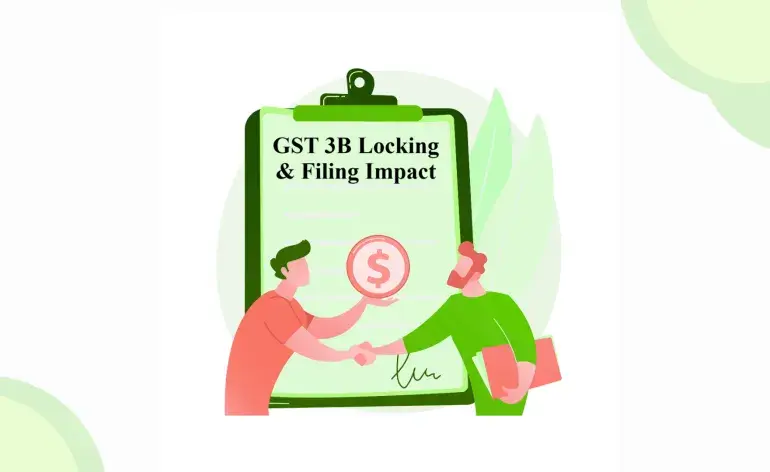The Impact of GST 3B Locking on GST Filing
Starting July 2025, businesses across India will face important changes in the way they file their GST returns. The government is introducing tighter rules to improve how accurately and on time taxes are filed. These updates include stricter controls on return data, filing timelines, and ITC claims.
For many businesses, this will mean a shift in how they manage their GST operations, focusing more on automation, data accuracy, and timely vendor collaboration. Manual processes and delayed reconciliations will no longer be safe options.
That’s where EaseMyGST steps in—to help you file with confidence, avoid penalties, and stay one step ahead of upcoming regulatory demands.
EaseMyGST is here to ensure you’re ready.
What’s Changing in GST Filing from July 2025?
1. GSTR-3B Liability Will Be Locked
Until now, taxpayers have had the flexibility to modify auto-drafted liabilities in GSTR-3B before filing. From July 2025, that flexibility ends.
- The liability data auto-populated in GSTR-3B (from GSTR-1 and other systems) will be locked.
- Businesses will no longer be able to change values manually once auto-drafted.
This change will increase the importance of accurate GSTR-1 reporting. Any mistakes in sales returns or invoices will carry through to your GSTR-3B without the ability to adjust.
It also raises the stakes for ERP integration and early-stage validations to ensure error-free reporting across all channels.
EaseMyGST ensures that all return data from ERP and POS is clean, aligned, and synced in real-time, eliminating the chances of last-minute surprises.
2. Time Limit for Filing Returns Fixed at 3 Years
Late filers, take note. The GST Council has fixed a hard deadline:
- No GST return, including GSTR-1, GSTR-3B, GSTR-9 etc., can be filed after three years from the due date.
Once this rule kicks in, missed filings become unrecoverable. Businesses will lose the ability to make corrections, adjustments, or claim ITC if deadlines are missed.
This rule puts added pressure on maintaining discipline in monthly operations.
EaseMyGST helps users stay alert with built-in deadline tracking, alerts per GSTIN, and quick reporting to highlight missed or delayed returns across locations.
3. Tightening ITC Claim Regulations
As more auto-populated data gets locked, the scope for ITC (Input Tax Credit) mismatches reduces.
- Vendors must file accurately and on time for buyers to claim ITC.
- More dependency on vendor compliance for your tax benefit.
The responsibility of accurate ITC claims is increasingly shared with your vendors. This means businesses must closely monitor vendor filing behaviour and status, and have a system that flags mismatches in GSTR-2A/2B early.
EaseMyGST automates this entire process ~ from fetching vendor GST data to tracking GSTIN status and generating vendor communication alerts. This ensures your team catches issues before it’s too late, saving ITC and effort.
What Does This Mean for Retailers and Businesses?
- More responsibility to ensure that upstream data is correct
- Need for real-time reconciliation and error detection
- Higher risk of notices for incorrect filing
- Tighter filing windows
The focus is shifting from corrections later to accuracy upfront.
How EaseMyGST Prepares You for These Changes
With the upcoming changes around return locking, fixed filing timelines, and tightened ITC eligibility, EaseMyGST equips your team with tools that go beyond compliance—it sets you up for efficient, proactive GST management.
1. Real-Time Reconciliation
EaseMyGST continuously compares your purchase data with GSTR-2A, 2B, and vendor filings.
Identify mismatches before filing
- Send automated reminders to vendors for correction
- Avoid delays in claiming Input Tax Credit (ITC)
This helps you stay updated on vendor filings and ensures you’re claiming the right ITC at the right time—no surprises at month-end.
2. Automated GSTR-1 and GSTR-3B Drafting
EaseMyGST automatically pulls invoice and return data from your ERP, POS, or accounting software.
- No need to enter details manually
- Ensure seamless match between GSTR-1 and GSTR-3B
- Prevent discrepancies that could lead to locked returns or notices
By automating data collection and population, your returns are more accurate, faster, and always aligned with source documents.
3. Alerting and Tracking Tools
Stay informed and in control with EMG’s smart alerts and visual trackers:
- Get notified about invoices pending reconciliation
- Alerts for missed uploads or deadlines
- Filter by GSTIN, site, or location to manage returns more efficiently
You’ll never miss a filing window again, even across multiple branches or GSTINs.
4. Historical Data Intelligence
EaseMyGST lets you analyze older filings and catch errors before the new 3-year filing cap kicks in.
- Spot discrepancies in past returns with smart filters
- Check eligibility of old ITC claims
- Monitor and act on approaching time limits
This foresight can help you avoid penalties by identifying recoverable credits and returns that are nearing lockout.
5. Seamless ERP & Ginesys Integration
Whether you're on Ginesys ERP, Tally, SAP, or another solution, EaseMyGST connects directly for smooth operations.
- No need for multiple logins or exports
- Central dashboard for reconciliation, validation, and return filing
- All GST activities tracked in one place
It’s built for modern businesses that value agility, accuracy, and scale.
Why Choose EaseMyGST Now
"Regulation is tightening. Automation isn’t optional anymore."
The sooner you align your systems with EaseMyGST, the smoother your transition will be.
Trusted by brands like Manyavar, Mufti, Style Bazaar, Soch, and more — EaseMyGST handles high-volume reconciliation, GSTR prep, e-invoicing and more, all from one intuitive platform.
GST compliance is evolving, and it’s clear: businesses that don’t automate will fall behind.
With GSTR-3B locking, ITC tightening, and strict deadlines, there is no room for error or delay.
EaseMyGST is your edge in this new compliance era.
Get audit-ready. Stay future-ready.

